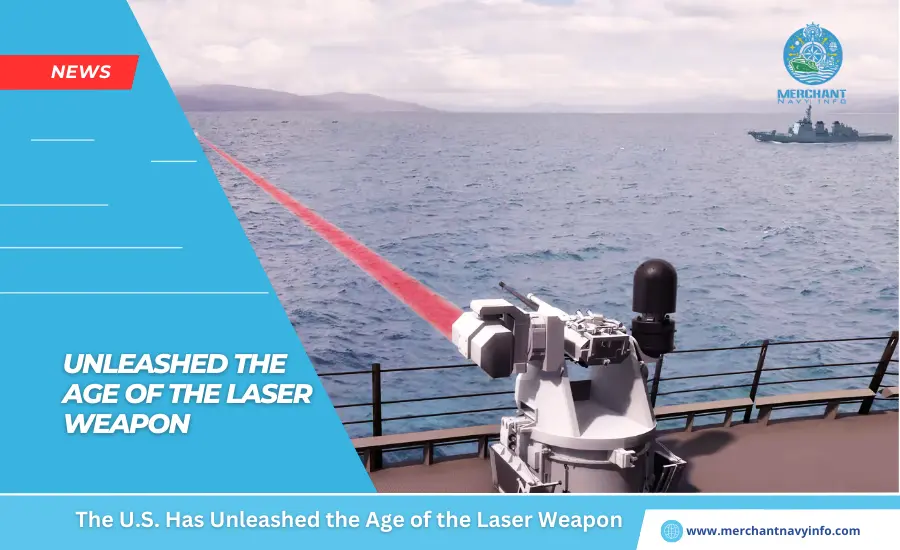
The U.S. Army has officially sent high-energy laser weapons overseas to protect U.S. forces and U.S. allies. From enemy drones, the military recently announced. This marks the first publicly known use of a directed energy system for air defense in military history. And also, according to one senior official, these weapons actively pose a threat from the air. The weapon, known as the Palletized High Energy Laser (P-HEL), developed by American defense company Blue Halo. Based on the company’s 20-kilowatt Locust laser weapon system, has arrived at an unspecified location overseas for the first time. Operational deployment took place “in November”. 2022, according to the company’s April press release. The second system arrived overseas “early this year.
” The Army initially declined to say where the P-HEL system was sent or whether it had “downed” an enemy drone. Citing operational safety concerns, but military acquisition. Top officials recently confirmed that the new laser weapon had actually been used. Neutralize the threat looming in the Middle East.” In some cases, it worked,” Doug Bush. Assistant secretary of the Army for acquisition, logistics, and also technology, told Forbes this month. “Under the right conditions, it is highly effective against certain threats.” P-HEL deployment comes as the U.S. military seeks to aggressively strengthen its air defense capabilities amid drone and missile attacks. Following the Oct. 7 Hamas attack in Israel, attacks on U.S. Navy warships by Iranian-backed militias in the Middle East and Yemen’s Houthi rebels in the Red Sea have increased dramatically.
Light at the End of the Tunnel
After American engineer and also physicist Theodore Maiman’s invention in the 1960s. The laser – technically an acronym for “Light Amplification by Stimulated Emission of Radiation”. Was nearly It quickly became the future weapon of choice for both countries. Science fiction writer and military planner. This was not surprising: when he first introduced his discovery to the country later that year. Maiman touted the potential scientific applications of his discovery. But lasers quickly became what he recalled as H.G. Wells’ vision of Mars’s “heat rays.”War of the Worlds” was featured prominently in L.A. With many of the headlines from the Los Angeles Herald’s debut work Variations” at the time. “Humanity has discovered the science fiction death ray,” says Jeff Hecht’s .
Actually, the laser was more of a ray of life than a ray of death,” Maiman later recalled, according to his memoir, as he considered the medical applications of his invention. Almost immediately, the Department of Defense began to explore everything from relatively practical applications, such as designators for laser-guided bombs, to far-fetched concepts, such as the 1980s Strategic Defense Initiative, also known as Star Wars.” began research into military uses of lasers. But it’s only in recent decades that the underlying technology has advanced to the point where laser weapons can be effective against their intended targets. In the mid-2000s, the Air Force successfully tested the Boeing 747-based YAL-1 airborne laser to counter ballistic missiles in flight, and the Zeus-HMMWV laser weapon neutralisation system installed on Army Humvees Deployed to Afghanistan and also Iraq to clear landmines, improvised explosive devices, and unexploded ordnance.
Cheap Threats
The development and use of directed energy weapons, such as lasers, have gained new urgency among world governments in recent years due to the rapid proliferation of relatively inexpensive, single-use attack drones in the professional militaries of both countries (see: in 2020). the Armenian-Azerbaijan conflict and Russia’s ongoing invasion of Ukraine), and irregular forces such as the Red Sea Houthis in Yemen, ISIS cells in Iraq and Syria, and Iranian-backed militias across the Middle East. In 2021, then-Commander of Central Command Marine Corps Gen. Frank McKenzie Jr. told U.S. lawmakers that armed commercial off-the-shelf drones were the largest for U.S. forces in the region since the advent of improvised explosive devices early in the war. Warned that it was a threat to the global war on terrorism.
This threat is very real. In January, a drone attack by Iranian-backed militias on a Jordanian outpost near the Syrian border killed three U.S. soldiers and injured more than 40 others. As of mid-February, more than 140 additional service members had been injured in U.S. strikes in Iraq and Syria since mid-October, 130 of whom suffered traumatic brain injuries, according to the Pentagon. The fact that more U.S. soldiers did not die in these attacks was essentially a blessing in disguise, according to Army Gen. Michael “Eric” Kurilla, the current commander of Central Command.
Problem in Need of a Solution
Even with additional training, most existing systems are still unable to meet evolving threats such as fast-moving drones and intercept-resistant cruise missiles. Significant performance improvements are required. Taking the Navy’s carrier-based 60-kilowatt laser weapon Helios as an example, the military wants to expand the system to 300 kilowatts to burn out the nose cones of incoming cruise missiles, said the Navy’s chief of surface warfare at the time. Said Major General Ron. Boxall explained earlier this year: In 2019, the fleet’s new Flight III Arleigh Burke-class destroyers were already overloaded (or, in Boxall’s words, “out of slot”) due to the operational requirements of the warship brand.
The new AN/SPY-6 Air. and missile defense radar. This energy demand will only increase as laser weapons become more robust to deal with increasingly complex threats.And even if laser weapons could be made to work effectively at low ranges with proper technology and training, U.S. soldiers would face complex logistical considerations if they were to continue to operate them. Laser weapons are highly complex machines, making repair and maintenance in harsh environments a major challenge for deployed military personnel who lack the proper tools and equipment.










